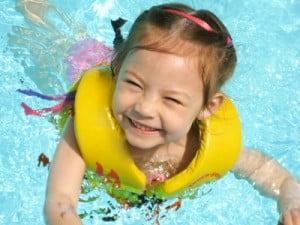 Summer is a time of swimming, baseball, outdoor playing, and families enjoying the warm weather together. But, summertime dangers do exist, with injuries and drownings being the top two leading causes of death in children. Knowledge is powerful and a few simple safety tips will ensure a summertime of fun for the entire family.
Summer is a time of swimming, baseball, outdoor playing, and families enjoying the warm weather together. But, summertime dangers do exist, with injuries and drownings being the top two leading causes of death in children. Knowledge is powerful and a few simple safety tips will ensure a summertime of fun for the entire family.
1. First and foremost, all family members should be protected against the harmful rays of the sun. There is no such thing as safe sunbathing. Avoid the midday sun between 10 a.m. and 3 p.m. and protect the skin even on cloudy days. For infants less than 6 months, the best protection is to keep the child in the shade and to keep skin protected by clothing. If that is not possible, sunscreen may be used on small areas of the body. Use a sunscreen with an SPF of at least 15, protecting against UVA and UVB rays. Apply 30 minutes before exposure and then reapply every 2 hours and after swimming. Sunglasses should be encouraged to protect the eyes. If sunburn occurs, the pain will last at least 48 hours–ibuprofen, moisturizing creams, cool baths and compresses will relieve the discomfort. For extensive blistering, seek the advice of your health care provider.
2. Insect bites can be a minor nuisance or a major problem and again, the best advice is prevention: avoid areas where insects congregate; avoid dressing in bright flowery clothing; discourage the use of perfumed soaps and lotions; apply an insect repellent with 10-30 percent DEET to clothing and areas of exposed skin. Insect repellents are not recommended for children less than 2 months old. For simple mosquito bites and chiggers, calamine lotion, baking soda paste, or non-prescription hydrocortisone cream can be applied to the bite for relief. Oral Benedryl may also be given in the recommended dosage.
3. Ticks should be removed with tweezers, applying steady upward traction. After the tick is removed, clean the area with soap and water and apply antibacterial ointment. If your child develops a fever, severe headache, joint swelling or bulls-eye rash, contact our office. Bee and wasp stings can be painful. If the stinger is present, you can remove it by scraping it with a credit card, but do not use tweezers because the traction can release additional venom. Rub a cotton ball soaked in meat tenderizer or use baking soda paste and cool compresses to relieve discomfort. Multiple stings (10 or more) may cause a toxic reaction and should be evaluated immediately. Call 911 if there is breathing difficulty.
4. Contact rashes from poison ivy, oak and sumac frequently occur due to sensitivity to the resin from the plant. A highly itchy, red blistery rash occurs 1-2 days after exposure and can persist for several weeks. Treatment with topical medication can reduce symptoms but does not cure it. Again prevention is important; learn to recognize and avoid the plant, wear protective clothing and use barrier creams (ivy block) when in endemic areas. Secondary infections can develop and should be evaluated by the office.
5. If you have a swimming pool, adults need to remain vigilant any time a child is in the pool. Never leave a child unattended in a pool. Keep infants and young children within an arm’s length. Make sure all gates are locked and in working order. If a non-swimming child is in the water use only a CPSC approved life vest, not inflatable swim aids, which give a child a false sense of confidence. The American Academy of Pediatrics encourages swim lessons for most children older than 4 years of age.
6. Swimmers ear (an infection of the ear canal, common in areas of high heat and humidity, characterized by pain when the ear lobe is tugged) can be prevented in children without tympanostomy tubes by using an equal part solution of white vinegar and rubbing alcohol-apply a few drops in the ear canal after swimming. Swimmers ear is more common after lake swimming. Call our office if you suspect your child has swimmers ear.
7. Helmet use for bicycles and skateboards are mandatory to keep your child safe. Always use proper-fitting helmets that meet CPSC standards. Also remember to keep your child hydrated in the heat, especially if he or she is engaging in physical activity. Offer fluids or water breaks every 20 minutes.
With these simple tips, you and your child will have a safe and enjoyable summer. For additional specific information on pool safety guidelines and other guidelines visit the Health Resources section of EsseHealth.com.
By Karen Diehl, CPNP, CLC
Karen Diehl is a Certified Pediatric Nurse Practitioner and Certified Lactation Counselor at the Esse Health Tesson Ferry Pediatrics Office
13303 Tesson Ferry Rd., Suite 150
St. Louis, MO 63128
Phone: (314) 842-5239

